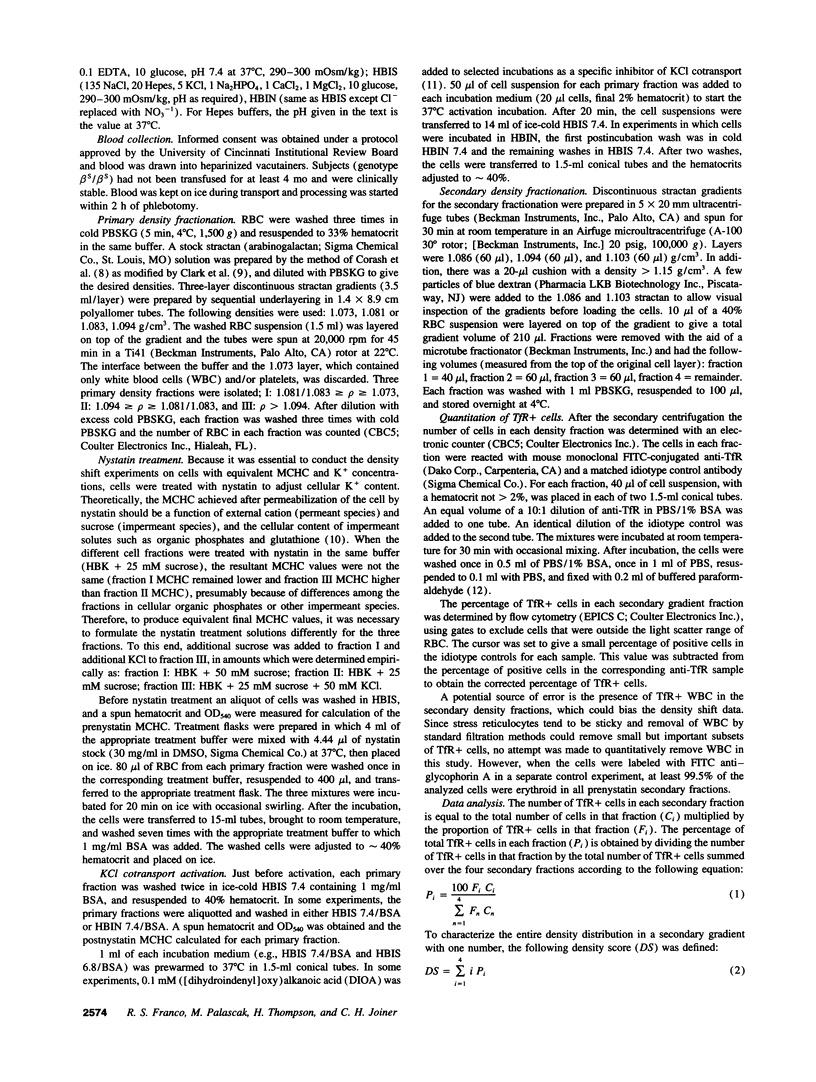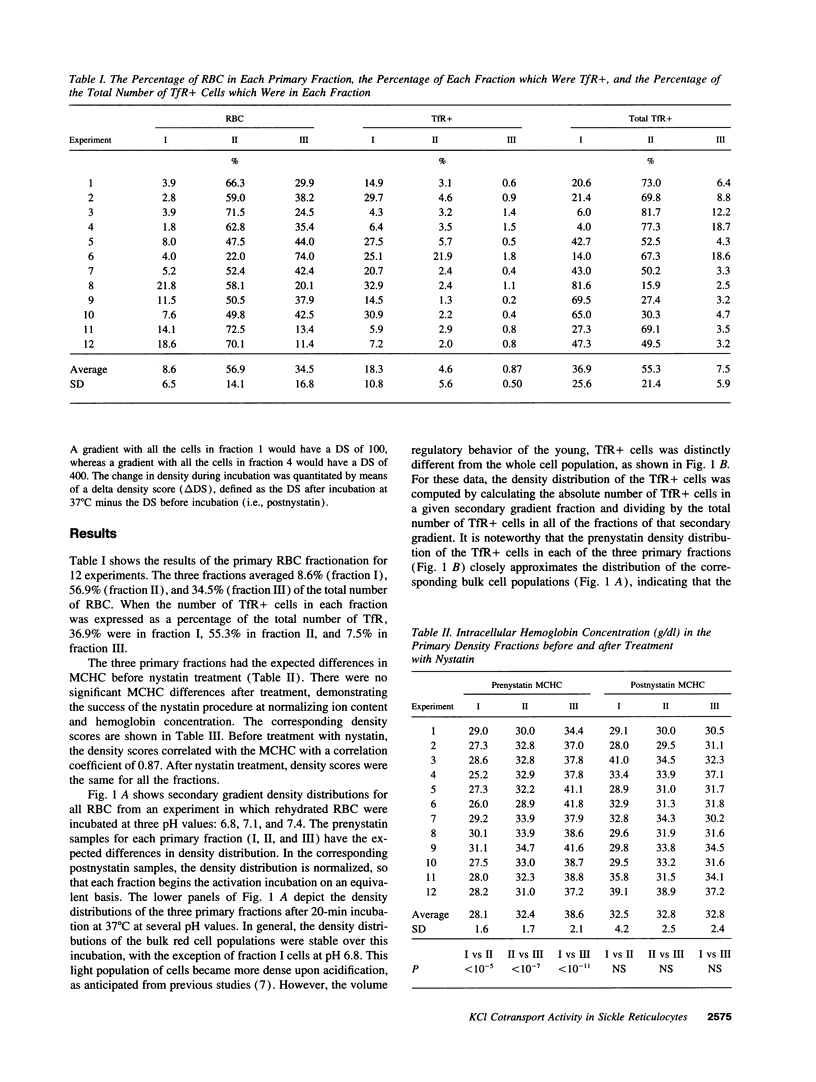Abstract
A subset of sickle cells becomes K(+)-depleted and dehydrated before or soon after leaving the bone marrow. These young cells may be identified in blood as transferrin receptor-positive (TfR+) dense reticulocytes. KCl cotransport, which is normally active in young erythroid cells with a maximum at pH 6.8, is a candidate pathway for K+ depletion of sickle reticulocytes. In this investigation, KCl cotransport activity was evaluated in young, TfR+ cells which had become dense in vivo and in age-matched cells which had retained normal hydration. Sickle erythrocytes were first separated into three primary density fractions, with care taken to preserve the in vivo hydration state. After normalization of intracellular hemoglobin concentration with nystatin, the cells were incubated at 37 degrees C for 20 min at pH 6.8 and 7.4. Before and after incubation, each primary fraction was separated into four secondary density fractions. The percentage of TfR+ cells in each secondary fraction was measured and a density distribution for TfR+ cells was determined for each primary fraction before and after incubation. The density shift during incubation was a measure of KCl cotransport. TfR+ cells from the denser primary fractions II and III had significantly more density shift than TfR+ cells from the light fraction I. Although the shifts were larger at low pH, differences between primary fractions were also observed at pH 7.4. These data indicate that the cells which become dense quickly in vivo have more KCl cotransport activity than those which remain light in vivo, and support this pathway as a primary mechanism for dehydration of young sickle cells.
Full text
PDF







Selected References
These references are in PubMed. This may not be the complete list of references from this article.
- Bertles J. F., Milner P. F. Irreversibly sickled erythrocytes: a consequence of the heterogeneous distribution of hemoglobin types in sickle-cell anemia. J Clin Invest. 1968 Aug;47(8):1731–1741. doi: 10.1172/JCI105863. [DOI] [PMC free article] [PubMed] [Google Scholar]
- Bookchin R. M., Ortiz O. E., Lew V. L. Evidence for a direct reticulocyte origin of dense red cells in sickle cell anemia. J Clin Invest. 1991 Jan;87(1):113–124. doi: 10.1172/JCI114959. [DOI] [PMC free article] [PubMed] [Google Scholar]
- Brittenham G. M., Schechter A. N., Noguchi C. T. Hemoglobin S polymerization: primary determinant of the hemolytic and clinical severity of the sickling syndromes. Blood. 1985 Jan;65(1):183–189. [PubMed] [Google Scholar]
- Brugnara C., Bunn H. F., Tosteson D. C. Regulation of erythrocyte cation and water content in sickle cell anemia. Science. 1986 Apr 18;232(4748):388–390. doi: 10.1126/science.3961486. [DOI] [PubMed] [Google Scholar]
- Brugnara C., Tosteson D. C. Cell volume, K transport, and cell density in human erythrocytes. Am J Physiol. 1987 Mar;252(3 Pt 1):C269–C276. doi: 10.1152/ajpcell.1987.252.3.C269. [DOI] [PubMed] [Google Scholar]
- Brugnara C., Tosteson D. C. Inhibition of K transport by divalent cations in sickle erythrocytes. Blood. 1987 Dec;70(6):1810–1815. [PubMed] [Google Scholar]
- Bunn H. F., Ransil B. J., Chao A. The interaction between erythrocyte organic phosphates, magnesium ion, and hemoglobin. J Biol Chem. 1971 Sep 10;246(17):5273–5279. [PubMed] [Google Scholar]
- Canessa M., Fabry M. E., Nagel R. L. Deoxygenation inhibits the volume-stimulated, Cl(-)-dependent K+ efflux in SS and young AA cells: a cytosolic Mg2+ modulation. Blood. 1987 Dec;70(6):1861–1866. [PubMed] [Google Scholar]
- Canessa M., Spalvins A., Nagel R. L. Volume-dependent and NEM-stimulated K+,Cl- transport is elevated in oxygenated SS, SC and CC human red cells. FEBS Lett. 1986 May 5;200(1):197–202. doi: 10.1016/0014-5793(86)80538-5. [DOI] [PubMed] [Google Scholar]
- Clark M. R., Greenquist A. C., Shohet S. B. Stabilization of the shape of sickled cells by calcium and A23187. Blood. 1976 Dec;48(6):899–909. [PubMed] [Google Scholar]
- Corash L. M., Piomelli S., Chen H. C., Seaman C., Gross E. Separation of erythrocytes according to age on a simplified density gradient. J Lab Clin Med. 1974 Jul;84(1):147–151. [PubMed] [Google Scholar]
- Ellory J. C., Hall A. C., Ody S. A., Poli de Figueiredos C. E., Chalder S., Stuart J. KCl cotransport in HbAA and HbSS red cells: activation by intracellular acidity and disappearance during maturation. Adv Exp Med Biol. 1991;307:47–57. doi: 10.1007/978-1-4684-5985-2_5. [DOI] [PubMed] [Google Scholar]
- Franco R. S., Barker-Gear R., Miller M. A., Williams S. M., Joiner C. H., Rucknagel D. L. Fetal hemoglobin and potassium in isolated transferrin receptor-positive dense sickle reticulocytes. Blood. 1994 Sep 15;84(6):2013–2020. [PubMed] [Google Scholar]
- Freedman J. C., Hoffman J. F. Ionic and osmotic equilibria of human red blood cells treated with nystatin. J Gen Physiol. 1979 Aug;74(2):157–185. doi: 10.1085/jgp.74.2.157. [DOI] [PMC free article] [PubMed] [Google Scholar]
- Hebbel R. P. Beyond hemoglobin polymerization: the red blood cell membrane and sickle disease pathophysiology. Blood. 1991 Jan 15;77(2):214–237. [PubMed] [Google Scholar]
- Johnstone R. M., Adam M., Hammond J. R., Orr L., Turbide C. Vesicle formation during reticulocyte maturation. Association of plasma membrane activities with released vesicles (exosomes). J Biol Chem. 1987 Jul 5;262(19):9412–9420. [PubMed] [Google Scholar]
- Johnstone R. M. The Jeanne Manery-Fisher Memorial Lecture 1991. Maturation of reticulocytes: formation of exosomes as a mechanism for shedding membrane proteins. Biochem Cell Biol. 1992 Mar-Apr;70(3-4):179–190. doi: 10.1139/o92-028. [DOI] [PubMed] [Google Scholar]
- Joiner C. H. Cation transport and volume regulation in sickle red blood cells. Am J Physiol. 1993 Feb;264(2 Pt 1):C251–C270. doi: 10.1152/ajpcell.1993.264.2.C251. [DOI] [PubMed] [Google Scholar]
- Joiner C. H., Platt O. S., Lux S. E., 4th Cation depletion by the sodium pump in red cells with pathologic cation leaks. Sickle cells and xerocytes. J Clin Invest. 1986 Dec;78(6):1487–1496. doi: 10.1172/JCI112740. [DOI] [PMC free article] [PubMed] [Google Scholar]
- Lew V. L., Freeman C. J., Ortiz O. E., Bookchin R. M. A mathematical model of the volume, pH, and ion content regulation in reticulocytes. Application to the pathophysiology of sickle cell dehydration. J Clin Invest. 1991 Jan;87(1):100–112. doi: 10.1172/JCI114958. [DOI] [PMC free article] [PubMed] [Google Scholar]
- Olivieri O., Vitoux D., Bachir D., Beuzard Y. K+ efflux in deoxygenated sickle cells in the presence or absence of DIOA, a specific inhibitor of the [K+, Cl-] cotransport system. Br J Haematol. 1991 Jan;77(1):117–120. doi: 10.1111/j.1365-2141.1991.tb07957.x. [DOI] [PubMed] [Google Scholar]
- Olivieri O., Vitoux D., Galacteros F., Bachir D., Blouquit Y., Beuzard Y., Brugnara C. Hemoglobin variants and activity of the (K+Cl-) cotransport system in human erythrocytes. Blood. 1992 Feb 1;79(3):793–797. [PubMed] [Google Scholar]
- Ortiz O. E., Lew V. L., Bookchin R. M. Deoxygenation permeabilizes sickle cell anaemia red cells to magnesium and reverses its gradient in the dense cells. J Physiol. 1990 Aug;427:211–226. doi: 10.1113/jphysiol.1990.sp018168. [DOI] [PMC free article] [PubMed] [Google Scholar]
- Russo V., Barker-Gear R., Gates R., Franco R. Studies with biotinylated RBC: (1) use of flow cytometry to determine posttransfusion survival and (2) isolation using streptavidin conjugated magnetic beads. Adv Exp Med Biol. 1992;326:101–107. doi: 10.1007/978-1-4615-3030-5_12. [DOI] [PubMed] [Google Scholar]
- Sunshine H. R., Hofrichter J., Eaton W. A. Requirement for therapeutic inhibition of sickle haemoglobin gelation. Nature. 1978 Sep 21;275(5677):238–240. doi: 10.1038/275238a0. [DOI] [PubMed] [Google Scholar]


